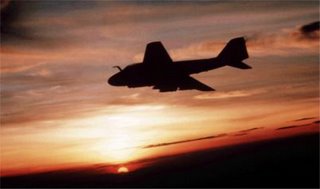Home is the Sailor…
Navy Aviator Missing In Action From Vietnam War is Identified
The Department of Defense POW/Missing Personnel Office (DPMO) announced yesterday that the remains of a U.S. serviceman, missing in action from the Vietnam War, have been identified and returned to his family for burial with full military honors. He is Lt. Cmdr. James E. Plowman, U.S. Navy, of Pebble Beach, Calif. He was buried yesterday at Arlington National Cemetery near Washington D.C.
On March 24, 1967, Plowman and a fellow officer departed the USS Kitty Hawk in their A-6A Intruder on a night strike mission of an enemy target in North Vietnam. Radar contact with their aircraft was lost over the Ha Bac Province as they were departing the target area. A pilot from another aircraft reported two missile warnings on his radar screen immediately before contact was lost with Plowman’s aircraft.
1967-68 was a tough period for the “Buckeyes” of VA-85. During that period they lost 8 aircrew, including the XO. Flying the A-6A and, in some cases the A-6B (which was modified for SAM supression) the Intruder crews were given some of the hardest targets to attack in North Vietnam. Typically they were deep in country and heavily defended. The A-6, with it’s all weather day/night capabilities usually ended up flying aginst the hardest targets at night. The final mission for (then) LtJG Plowman (B/N) and his pilot, LCDR John Ellison (who was also the squadron Ops Officer) was flying SAM supression — here is a summary of their mission (courtesy The Virtual Wall):
On 24 March, LCDR John “Buzz” Ellison and LTJG Jim Plowman launched in A-6A BuNo 151587 as part of a strike force directed against the Bac Giang thermal power plant in North Vietnam. The target was heavily defended by SAMs and a full spectrum of conventional anti-aircraft weaponry. Ellison and Plowman were tasked with SAM suppression for the bombers. After the strike was completed, friendly radar flight following tracked the BUCKEYE aircraft as it headed toward the Gulf of Tonkin, but the track terminated in the vicinity of Ha Bac Province near the Vietnam/China border. Combat SAR was initiated. Voice contact was achieved with LCDR Ellison, but neither he nor Plowman was rescued. Both men were placed in “Missing in Action” status.
The North Vietnamese never acknowledged capturing either Ellison or Plowman, nor did they report that either man had been killed. The two men simply disappeared.
Even so, the two men were never placed in POW status, and on Thursday, 04/18/1974, the Secretary of the Navy approved a Presumptive Finding of Death for now-Lieutenant Commander Plowman, changing his status to “Died while Missing”.
Between 1993 and 1996, joint U.S.-Socialist Republic of Vietnam (S.R.V.) teams, led by the Joint POW/MIA Accounting Command (JPAC), conducted three investigations in the province. The team interviewed two local villagers who saw the 1967 crash, and both men recalled seeing human remains at the site. The team also surveyed the purported crash site and found several small fragments of aircraft wreckage. In 1996, another joint U.S./S.R.V. team excavated the suspected crash site. The team found human remains from amid the scattered wreckage. The team was also handed some remains by a local villager who claimed to have recovered it while scavenging the crater for metal.
I observed the service Wednesday by happenstance — the building I work in now sits to one side of Arlington, and not a day passes by but that I see another burial procession enroute to the final resting place. The size of the detail varies, but I can say that from personal experience (being the senior Navy rep for the detail) the degree of solemnity and honor according the deceased is the same from the accompanying detail. On those occasions I will stop, come to attention and hold a salute until the detail passes. The usual background busy noise of this area of DC seems to recede and I hear clearly the sound of the caisson’s horses hoofs on the pavement.
There are some remembrances posted on the Virtual Wall website — here is one from one of his fraternity brothers:
To all of us he was Jim not James, though he assigned nicknames to most of us. I became “Seagull” because of my Utah background as we trooped though out pledge year gaining acceptance as men yet still boys making our way into an unknown world, sharing the days of the Kennedy Assasination, the occasional nights of fraternity partying and many hours of study deep in the bowels of Suzallo Library.
Perhaps more than most of us, Jim knew where he was headed. His pride in ROTC showed in the crispness of his uniform and his devotion to his faith. But he still was one of us, giving and gaining strength in the periods of indecision we all shared. Jim was one of two of my 24 pledge brothers who didn’t return. I learned of both while in Basic Training, a few miles, yet great gaps apart from where he was raised.
And today as the others age, Jim lives on in scrap- and yearbook photos, memories and occasional dreams as a young red headed guy. And Jim lives in history for his nobility.
— From a Fraternity Brother and friend,Kent Carthey
For almost twenty years a family has had to live with the open-ended question of “what if” that even a “Died while Missing” status conveys. Now they can finally close that book — welcome home…
UNDER the wide and starry sky
Dig the grave and let me lie:
Glad did I live and gladly die,
And I laid me down with a will.
This be the verse you ‘grave for me:
Here he lies where he long’d to be;
Home is the sailor, home from the sea,
And the hunter home from the hill.
– Robert Louis Stevenson
(‘Requiem’ from Underwoods)

